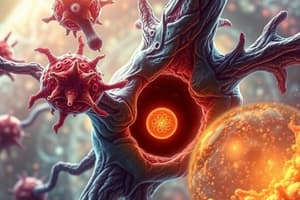Podcast
Questions and Answers
What is the purpose of the isopod replacing a fish's tongue?
What is the purpose of the isopod replacing a fish's tongue?
- To protect the fish from predators
- To eventually kill the fish
- To act as a living prosthetic tongue (correct)
- To help the fish eat more efficiently
How does the Braconid wasp harm the tomato hornworm caterpillar?
How does the Braconid wasp harm the tomato hornworm caterpillar?
- By providing additional nutrients to the caterpillar
- By forming a symbiotic relationship with the caterpillar
- By feeding on the insides of the caterpillar (correct)
- By laying eggs in the caterpillar to protect it
What is the role of tapeworms in infected organisms?
What is the role of tapeworms in infected organisms?
- Helping the host digest food efficiently
- Feeding on the host's digested food or depriving the host of nutrients (correct)
- Absorbing excess nutrients from the host
- Protecting the host from external threats
In mutualism, how do both species interact?
In mutualism, how do both species interact?
What happens to a caterpillar infected by Braconid wasps as they mature?
What happens to a caterpillar infected by Braconid wasps as they mature?
What is the primary benefit for a flower in its interaction with bees?
What is the primary benefit for a flower in its interaction with bees?
How does the whale benefit from its interaction with barnacles?
How does the whale benefit from its interaction with barnacles?
How does a tapeworm obtain its food inside a host organism?
How does a tapeworm obtain its food inside a host organism?
What happens to a fish once its tongue is replaced by an isopod?
What happens to a fish once its tongue is replaced by an isopod?
What does the Braconid wasp do to the tomato hornworm caterpillar?
What does the Braconid wasp do to the tomato hornworm caterpillar?
How does a tapeworm obtain nutrients inside a host organism?
How does a tapeworm obtain nutrients inside a host organism?
What is the outcome for a fish after having its tongue replaced by an isopod?
What is the outcome for a fish after having its tongue replaced by an isopod?
In the interaction between a whale and barnacles, what benefit do barnacles receive?
In the interaction between a whale and barnacles, what benefit do barnacles receive?
How does the isopod benefit from replacing a fish's tongue?
How does the isopod benefit from replacing a fish's tongue?
What is the primary relationship between bees and flowers?
What is the primary relationship between bees and flowers?
How does a tapeworm affect its host organism?
How does a tapeworm affect its host organism?
What distinguishes mutualism from commensalism?
What distinguishes mutualism from commensalism?
Study Notes
Symbiosis
- Symbiosis is an interaction between two different species where at least one organism benefits.
- It occurs when organisms occupy the same space, compete for resources, or interact with each other.
Endo vs Ecto Symbiosis
- Endosymbiosis: a smaller organism lives within the cells, tissues, or structures inside a host organism's body.
- Example: microorganisms in termites' gut help digest wood.
- Ectosymbiosis: one organism lives on the surface of another.
- Examples: barnacles on humpback whales, European mistletoe on trees.
Types of Symbiotic Relationships
Mutualism
- Both organisms benefit.
- Each organism provides needed resources to the other, such as food, shelter, locomotion, or protection.
- Examples:
- Pistol shrimp and goby: shrimp digs burrow, goby guards entrance.
- Nile crocodile and Egyptian plover: plover cleans crocodile's teeth.
- Clownfish and sea anemone: clownfish eats leftover food, anemone provides protection.
Commensalism
- One organism benefits, the other is not affected.
- Examples:
- Cattle egrets and cows: egrets catch insects stirred up by cows.
- Imperial shrimp and sea cucumber: shrimp gets transportation and protection.
- Shark and remora fish: remora gets transportation, protection, and food scraps.
Parasitism
- One organism benefits, the other is harmed.
- Examples:
- Cymothoa exigua (tongue-eating isopod) and fish: isopod attaches to fish's tongue, sucks blood, and replaces the tongue.
- Braconid wasps and tomato hornworm: wasps lay eggs inside hornworm, feed on its insides, and kill it.
- Tapeworms and infected organisms: tapeworms attach to intestines, feed on partially digested food, and deprive host of nutrients.
Studying That Suits You
Use AI to generate personalized quizzes and flashcards to suit your learning preferences.
Description
Explore the concept of symbiosis in biology, where different species interact in various ways. Learn about the endosymbiosis and ectosymbiosis relationships and how they contribute to the ecosystem.




